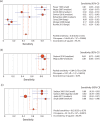Evaluation of brief screening tools for neurocognitive impairment in HIV/AIDS: a systematic review of the literature
- PMID: 23751261
- PMCID: PMC3814629
- DOI: 10.1097/QAD.0b013e328363bf56
Evaluation of brief screening tools for neurocognitive impairment in HIV/AIDS: a systematic review of the literature
Abstract
Objective(s): To systematically review literature on brief screening tools used to detect and differentiate between normal cognition and neurocognitive impairment and HIV-associated neurocognitive disorders (HANDs) in adult populations of persons with HIV.
Design: A formal systematic review.
Methods: We searched six electronic databases in 2011 and contacted experts to identify relevant studies published through May 2012. We selected empirical studies that focused on evaluating brief screening tools (<20 min) for neurocognitive impairment in persons with HIV. Two reviewers independently reviewed retrieved literature for potential relevance and methodological quality. Meta-analyses were completed on screening tools that had sufficient data.
Results: Fifty-one studies met inclusion criteria; we focused on 31 studies that compared brief screening tools with reference tests. Within these 31 studies, 39 tools were evaluated and 67% used a comprehensive neuropsychological battery as a reference. The majority of these studies evaluated HIV-associated dementia (HAD). Meta-analyses demonstrated that the HIV Dementia Scale (HDS) has poor pooled sensitivity (0.48) and the International HIV Dementia Scale (IHDS) has moderate pooled sensitivity (0.62) in detecting a range of cognitive impairment. Five newer screening tools had relatively good sensitivities (>0.70); however, none of the tools differentiated HAND conditions well enough to suggest broader use. There were significant methodological shortcomings noted in most studies.
Conclusion: HDS and IHDS perform well to screen for HAD but poorly for milder HAND conditions. Further investigation, with improved methodology, is required to understand the utility of newer screening tools for HAND; further tools may need to be developed for milder HAND conditions.
© 2013 Wolters Kluwer Health | Lippincott Williams & Wilkins
Figures
References
-
- Rourke SB, Gill J, Rachlis A, Carvalhal A, Collins E, Arbess G, et al. The Centre for Brain Health in HIV/AIDS HIV-associated neurocognitive disorders (HAND) in men and women on cART and suppressed plasma viral load: prospective results from the OHTN cohort study. Can J Infect Dis Med Microbiol 2013; 24:12A.Canadian Association for HIV Research (CAHR) Conference; 2013; Vancouver, BC. 11–14 April 2013
-
- Janssen RS, Cornblath DR, Epstein LG, Foa RP. Nomenclature and research case definitions for neurologic manifestations of human immunodeficiency virus-type 1 (HIV-1) infection. Report of a Working Group of the American Academy of Neurology AIDS Task Force. Neurology 1991; 41:773–785 - PubMed
Publication types
MeSH terms
Grants and funding
LinkOut - more resources
Full Text Sources
Other Literature Sources
Medical
Miscellaneous




